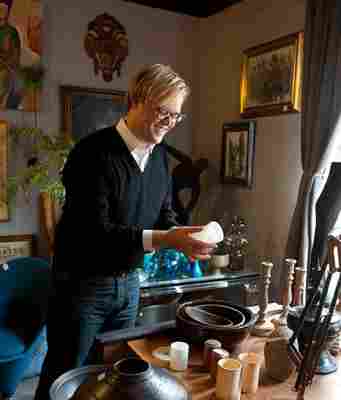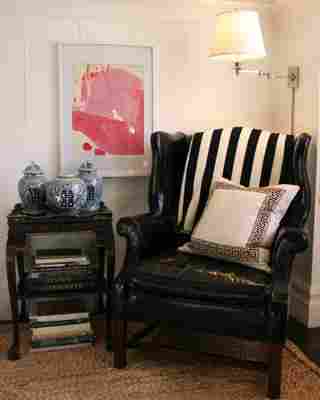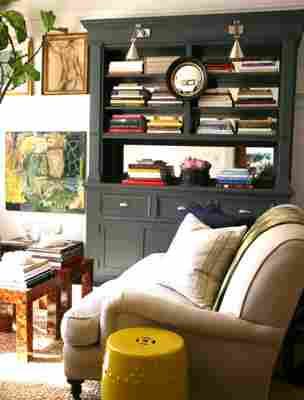I hate to mention the still rather dreary economy (let’s hope it’s on the upswing), but it does affect a lot of people who want either more space or perhaps a little less. San Francisco designer Grant Gibson is often in the spotlight as a young designer to watch. He is known for a crisp and classic aesthetic—one that could include a Lindsey Adelman chandelier as easily as a classical urn. Despite his success and growing portfolio, he has decided to stay in his modest rental a bit longer, shifting perspective rather than moving house. So I thought I’d ask him for advice on upgrading a home you don’t actually own and how to get the best return on your investment of time as well as money.
I hate to mention the still rather dreary economy (let’s hope it’s on the upswing), but it does affect a lot of people who want either more space or perhaps a little less. San Francisco designer Grant Gibson is often in the spotlight as a young designer to watch. He is known for a crisp and classic aesthetic—one that could include a Lindsey Adelman chandelier as easily as a classical urn. Despite his success and growing portfolio, he has decided to stay in his modest rental a bit longer, shifting perspective rather than moving house. So I thought I’d ask him for advice on upgrading a home you don’t actually own and how to get the best return on your investment of time as well as money.

Gibson does not want to give up his Presidio Heights location—“I walk to everything,” he explains—but he would like more space. “I dream of taking one of these houses with a peaked roof that has attic bedrooms and blowing them all out for a master.” But not quite yet: The designer has decided that waiting another year makes the most sense. Still, after being in his current spot for the past seven years, he wanted to make it feel new.
“After the apartment was published [in The New York Times ], I became a little tired of the whole look,” he says. Which is not to say that the look was tired. Gibson’s apartment was detailed and layered, each surface carefully styled with glass, books, and objets. “I wanted it to feel younger and fresher—I wanted to interject more color,” he notes, while creating a cleaner, less-cluttered look. “When I look back I’m shocked at how much stuff I had out. My living room and dining room resembled an antiques store.”

Gibson feels that his home is a laboratory for his work. “I can play with my own space more than I can with my clients’, though they seem to be asking for more color, too,” he says. “Also, I won’t be here forever, so I feel like I can have some fun with it.”
At the same time, Gibson—like anyone living in a rented apartment—didn’t want to feel that he’d overspent on renovations to a space he doesn’t own. “With a rental, you have to think of how you spend money in a different way,” he says. “I had had some thoughts of changing the Formica countertops in my kitchen to marble, but I realized it wasn’t the best use of my money.” As it turned out, minor changes, especially in the living room, made a big impact.
He started by editing to make the space feel cleaner and more modern, replacing the living room’s dark Oriental carpet with a lighter sea-grass rug, for example. He also got rid of the glass-topped brass cocktail table and replaced it with a pair of versatile square faux-tortoiseshell Parsons tables. Then he began stirring in color. “I do like a neutral base, which makes it easy to change art or pillows and accessories.”

Gibson decided to keep the walls white, but he changed the living room’s built-in bookcase to a charcoal gray, using Farrow & Ball’s Down Pipe. “To me, splurging on paint like Farrow & Ball didn’t seem like that much of a stretch,” says Gibson. “A couple of gallons of good paint doesn’t break the bank.”
The bookcase, once home to layers of pictures and objects, now holds simple stacks of books, and a graphic convex mirror has replaced an old master-ish portrait. “My design books are there, along with some auction catalogues,” Gibson says. “I actually use all of the them—I’ll pull books out over a glass of wine to look for inspiration.”
The next step was an infusion of contemporary art, which adds bursts of life where dark and serious portraits formerly reigned. A vibrant oil—an unsigned thrift-shop discovery—joins the conversation at seated eye level in the living room, while a painting of colorfully clad spectators peers out from between a pair of brass obelisks on a Biedermeier secretary.
For his fabrics, Gibson opted for solids or for minimal pattern, as with the Greek key pillows on the sofa and, in an alcove window, a French dining chair with custom leather upholstery the color of a shiny geranium leaf. The powder room, meanwhile, has leapt to life with a coat of Farrow & Ball’s Charlotte’s Locks, a vivid orange. “Neutrals can be one-sided,” Gibson notes. “I have been pushing myself. I am inspired by other designers who use bold colors. While I’m drawn to history, I like to take a fresh approach.”
